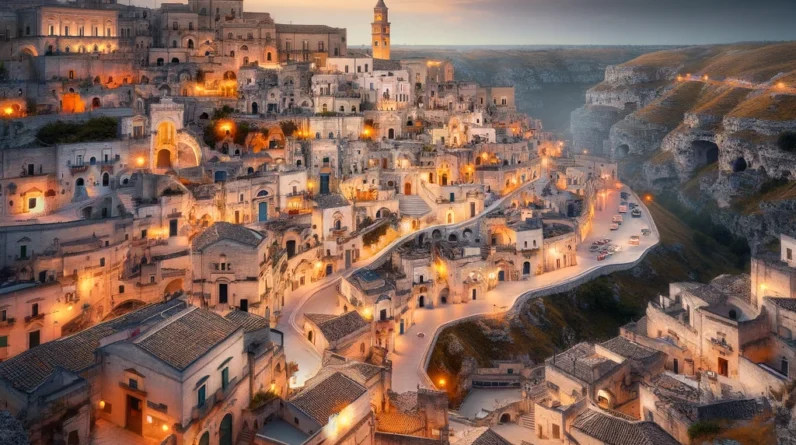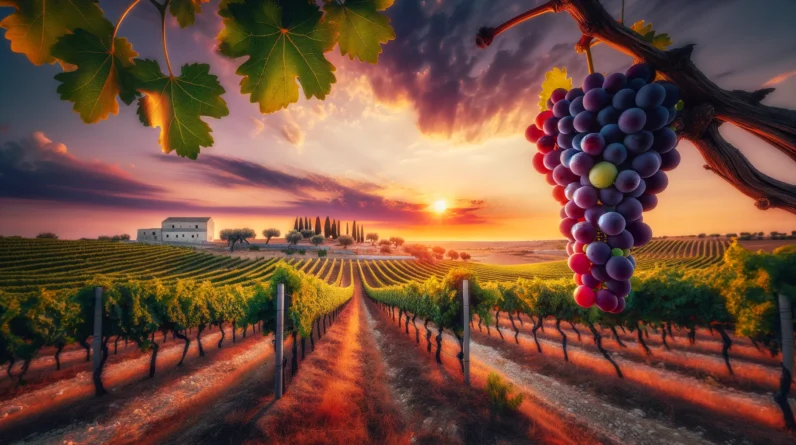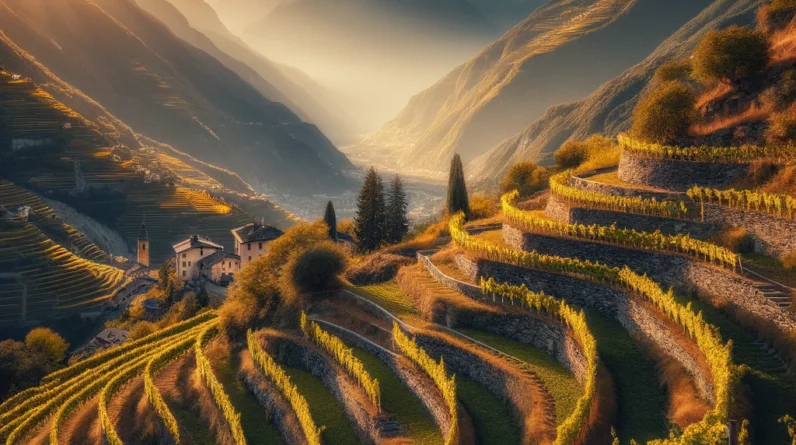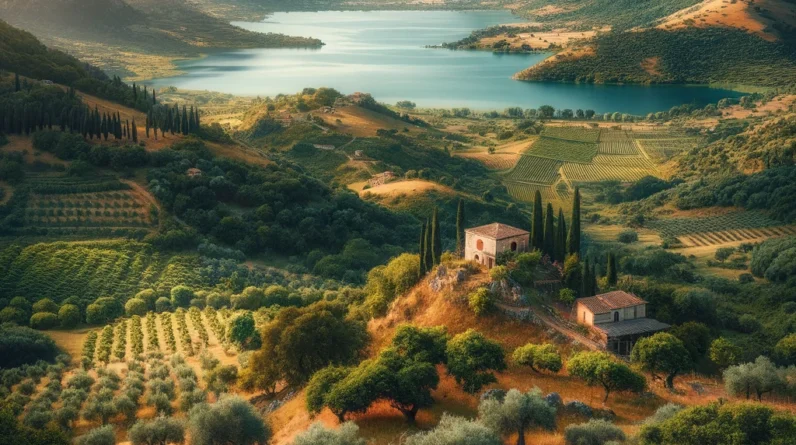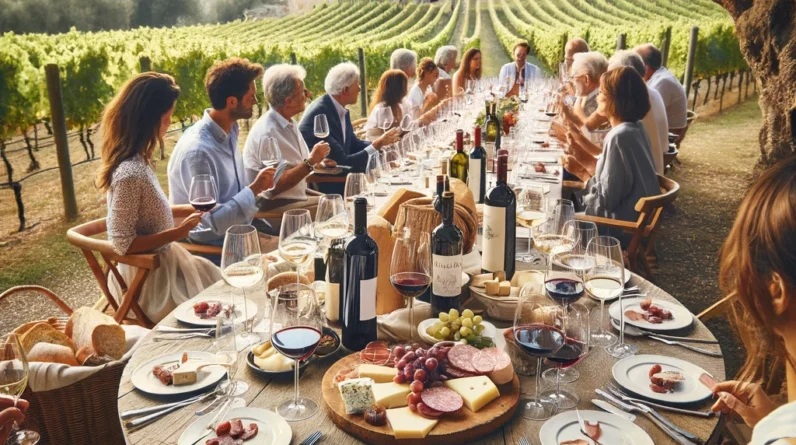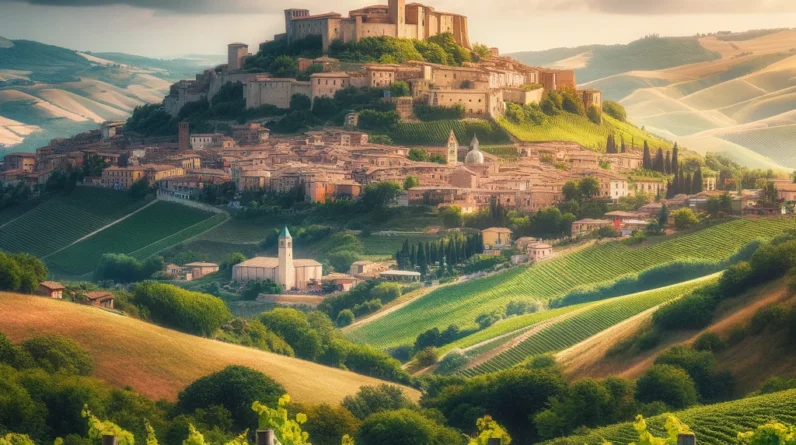
Tuscany Unveiled: A Journey Through the Heart of Italian Wine Country
Welcome to Tuscany, a land where the rolling hills whisper stories of ancient vines, and each glass of wine is a testament to a legacy steeped in tradition and passion.
This is not just a region; it’s a vibrant tapestry of history, culture, and flavors waiting to be explored.
In our comprehensive guide, we embark on a journey through the enchanting world of Tuscan wines and vineyards, unraveling the secrets that make this Italian paradise a haven for wine lovers worldwide.
From the rustic charm of Chianti to the bold elegance of Brunello, we delve into the diverse wine styles that define Tuscany.
We invite you on a picturesque tour of vineyards, offer insights into the best travel tips for wine tourism, and reveal how the rich history and culture of this region have shaped its winemaking.
Whether you’re a connoisseur, a curious traveler, or simply a lover of good wine, join us as we uncork the magic of Tuscany, one bottle at a time.
Get ready to indulge in a sensory experience where every sip tells a story and every view takes your breath away.

Exploring Tuscan Wines: A Tapestry of Flavors
Cultural and Historical Context: More Than Just Wine
Tuscany’s wine history is as deep as its roots in the soil.
The region’s Wine-making History dates back to Etruscan times, evolving through centuries.
Tuscan wines are part of its cultural fabric, with festivals and traditions celebrating this heritage.
The region’s Wine Laws (like DOC and DOCG) ensure quality and authenticity, preserving the legacy.
The Essence of Terroir
Tuscany, a region in central Italy, is a name that resonates with wine enthusiasts worldwide.
Its terroir, a French term that encompasses the complete natural environment in which a particular wine is produced, is fundamental to understanding the uniqueness of Tuscan wines.
This terroir includes not just the soil, but also the topography, climate, and the local winemaking traditions that have been honed over centuries.
Diverse Grape Varieties
Central to Tuscan viticulture is the Sangiovese grape, the cornerstone of the region’s most renowned wines such as Chianti, Brunello di Montalcino, and Vino Nobile di Montepulciano.
This red grape is celebrated for its versatile nature, capable of producing everything from approachable, everyday wines to complex, age-worthy vintages.
Beyond Sangiovese, other red grapes like Merlot, Cabernet Sauvignon, and Syrah have found a home in Tuscany, particularly in the production of the innovative Super Tuscan wines.
White wine grapes, though less prominent, also play a significant role, with varieties like Trebbiano, Vermentino, and Vernaccia contributing to the region’s oenological diversity.
| Grape Variety | Flavor Profile | Usage in Tuscany | Type (Red/White) |
|---|---|---|---|
| Sangiovese
| Red cherry, earthy, herbal, tomato leaf | Chianti, Brunello di Montalcino, Vino Nobile di Montepulciano | Red |
| Cabernet Sauvignon
| Black cherry, cedar, spices | Super Tuscans, Bolgheri | Red |
| Merlot
| Plum, black cherry, herbal notes | Super Tuscans, Bolgheri, blends | Red |
| Syrah
| Dark fruit, pepper, spices | Blends, IGT wines | Red |
| Cabernet Franc
| Raspberry, bell pepper, cassis, herbaceous | Blends, especially in Bolgheri | Red |
| Canaiolo
| Soft cherry, floral, spice | Chianti (traditional blends), Vin Santo (red grapes) | Red |
| Colorino
| Deep color, tannic, subtle fruit | Chianti, used to add color and tannins to blends | Red |
| Ciliegiolo
| Cherry, soft tannins, fresh | Blends, single varietal wines in some areas | Red |
| Trebbiano Toscano
| Lemon, peach, mineral | Vin Santo, traditional white blends | White |
| Vermentino
| Citrus, almond, green apple, mineral | Coastal areas, white IGT wines | White |
| Vernaccia
| Citrus, floral, almond, mineral | Vernaccia di San Gimignano | White |
| Malvasia Bianca
| Floral, peach, honey | Vin Santo, dessert wines, some white blends | White |
Soils: A Mosaic of Richness
The soils of Tuscany are a patchwork of types, each imparting unique qualities to the wine.
In Chianti, the soils are predominantly alberese (a type of limestone) and galestro (a rocky marl), ideal for Sangiovese, giving the wines their characteristic minerality and acidity.
The coastal areas, including Bolgheri, have more sandy soils, which are excellent for Bordeaux-style blends, contributing to the softer tannins and ripe fruit flavors of the Super Tuscans.
Clay, schist, and sandy loam are other soil types found across the region, each influencing the grapevines differently.
Climate: The Mediterranean Influence
Tuscany’s climate is quintessentially Mediterranean, marked by warm, sunny days and cool evenings.
This diurnal temperature variation is crucial for the slow and even ripening of grapes, essential for developing a balance of sugars and acids in the wine.
The region’s hilly landscape provides not just scenic beauty but also varying altitudes and microclimates, allowing winemakers to cultivate grapes in conditions that best suit their specific needs.
Coastal breezes from the Tyrrhenian Sea also play a role, especially in the coastal sub-regions, adding a refreshing saline touch to the wines.
Tuscany’s wine region is a complex and varied tapestry, rich in history, culture, and natural diversity.
Its terroir, from the rolling hills and varied soils to the warm, Mediterranean climate, creates an ideal environment for winemaking.
The combination of traditional grape varieties like Sangiovese with innovative winemaking approaches has placed Tuscany at the forefront of the wine world, offering an array of wines that are as diverse as they are captivating.
Each bottle from this illustrious region is a reflection of its unique terroir, a true embodiment of the land from which it comes.

Vineyard Exploration
Tuscany is not just about wines; it’s an experience.
Vineyard Tours are popular, offering insights into winemaking processes and grape cultivation.
Many vineyards also offer Wine Tastings, where you can savor various wines right where they’re made.
Some estates, like those in Chianti or Montalcino, offer Lodging, blending luxury with rustic charm, amidst rolling hills and vine-clad landscapes.
| Vineyard | Designation | Primary Grapes |
|---|---|---|
| Antinori
| Chianti Classico DOCG | Sangiovese, Cabernet Sauvignon |
| Biondi-Santi
| Brunello di Montalcino DOCG | Sangiovese |
| Tenuta San Guido
| Bolgheri Sassicaia DOC | Cabernet Sauvignon, Cabernet Franc |
| Ornellaia
| Bolgheri Superiore DOC | Cabernet Sauvignon, Merlot, Cabernet Franc |
| Castello Banfi
| Brunello di Montalcino DOCG | Sangiovese |
| Castello di Ama
| Chianti Classico DOCG | Sangiovese, Merlot |
| Tenuta dell’Ornellaia
| Bolgheri DOC | Merlot, Cabernet Sauvignon, Cabernet Franc |
| Frescobaldi
| Chianti Rufina DOCG | Sangiovese, Merlot |
| Masseto
| Toscana IGT | Merlot |
| Fontodi
| Chianti Classico DOCG | Sangiovese |
Designation Key:
- DOCG (Denominazione di Origine Controllata e Garantita) is the highest classification for Italian wines, denoting controlled production methods and guaranteed wine quality.
- DOC (Denominazione di Origine Controllata) represents a step below DOCG in terms of strictness of the wine laws, but still signifies a high-quality wine.
- IGT (Indicazione Geografica Tipica) is a more flexible classification, allowing winemakers to experiment with grape varieties and winemaking techniques.
This table captures some of the most prestigious and celebrated vineyards in Tuscany.
Each one of these names holds a story, a unique approach to winemaking, and contributes significantly to the reputation of Tuscan wines on the global stage.
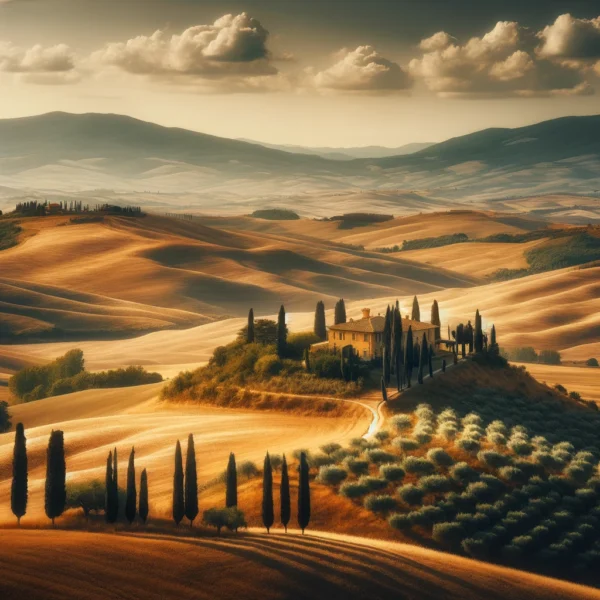
Winemaking Techniques in Tuscany
Tuscan winemaking is a blend of tradition and innovation, utilizing techniques that have evolved over centuries while also embracing modern advancements.
Here’s an overview of key winemaking techniques used in Tuscany.
Selective Grape Harvesting
Quality is paramount in Tuscan winemaking.
Grapes are often handpicked, with winemakers selectively harvesting to ensure only the best grapes are used.
This careful selection is crucial for producing high-quality wines.
Use of Indigenous Yeast
Many Tuscan winemakers prefer indigenous yeasts for fermentation.
These naturally occurring yeasts can add complexity and a unique sense of terroir to the wines.
Controlled Fermentation
Temperature-controlled fermentation is a common modern technique in Tuscany, allowing winemakers to precisely manage the fermentation process.
This control is vital for preserving the grapes’ natural flavors and achieving the desired balance in the wine.
Aging in Oak Barrels
Aging in oak is a traditional technique that remains popular in Tuscany.
Oak barrels impart tannins and flavors like vanilla and spice to the wine, adding complexity.
The type of oak (French, Slovenian, or American), the size of the barrel, and the duration of aging vary depending on the wine style and winemaker’s preference.
Sangiovese and Blending
In many Tuscan wines, especially Chianti and Brunello di Montalcino, Sangiovese is the star.
However, blending with other grape varieties, both local and international, is a common practice, especially in Super Tuscan wines.
This blending is done to achieve specific flavor profiles and add complexity.
Governo Method
This traditional Tuscan technique, historically used in Chianti, involves adding partially dried grapes or grape must to a wine partway through or after fermentation.
It can kickstart a second fermentation, adding body, sweetness, and alcohol content.
Appassimento
Used for Vin Santo (a sweet Tuscan dessert wine), this method involves drying grapes (usually Trebbiano and Malvasia) to concentrate their sugars before fermentation.
The grapes are dried on straw mats or hanging racks for several months.
Sustainable and Organic Practices
There’s a growing trend towards sustainable, organic, and biodynamic practices in Tuscan vineyards.
These methods focus on ecological balance, minimal intervention, and the absence of synthetic chemicals, reflecting a respect for the land and a desire to express its natural character.
Bottle Aging
Before release, many high-quality Tuscan wines are aged in the bottle for several months to several years.
This aging helps the wines to develop and integrate their flavors, creating a smoother, more harmonious profile.
These techniques, from careful vineyard management to meticulous aging, reflect the dedication of Tuscan winemakers to their craft.
They balance the region’s rich winemaking heritage with a willingness to innovate, resulting in wines that are both traditional and contemporary, capturing the essence of Tuscany in every glass.

The Uniqueness of Tuscan Wines
Tuscan wines hold a special allure in the world of winemaking, and there are several compelling reasons for this.
Rich History and Tradition
Tuscan winemaking dates back to ancient times, with Etruscans and later Romans cultivating vines.
This deep historical foundation adds a layer of romance and authenticity to Tuscan wines that is hard to replicate.
Diversity of Styles
From the robust and age-worthy Brunello di Montalcino to the more accessible and versatile Chianti, and the innovative Super Tuscans, the range of styles in Tuscan wines is staggering.
This variety caters to a wide range of palates and occasions.
The Sangiovese Grape
This grape is the backbone of many Tuscan wines. Its ability to reflect the terroir and its versatility in producing different styles of wine make it a favorite among winemakers and wine lovers.
Innovative Winemaking
Tuscan winemakers are known for balancing tradition with innovation.
The development of Super Tuscans, which often blend native grapes like Sangiovese with international varieties such as Cabernet Sauvignon and Merlot, is a prime example of this innovative spirit.
Unique Terroir
The Tuscan landscape, with its rolling hills, varied microclimates, and diverse soil types (like the alberese and galestro soils in Chianti), contributes significantly to the unique quality and taste of its wines.
The region’s climate, influenced by the Mediterranean, provides ideal growing conditions for grapes.
Global Acclaim and Quality
Tuscan wines have consistently gained international acclaim.
The region boasts numerous DOC and DOCG areas (Denominazioni di Origine), testaments to the quality and prestige of its wines.
Cultural Integration
Wine is deeply integrated into Tuscan culture and lifestyle, adding to its appeal.
The wine is not just a product but a part of the region’s heritage, celebrated through festivals, paired exquisitely with local cuisine, and featured in local art and literature.
Tourism and Experience
Tuscany itself is a draw, with its breathtaking landscapes, historic architecture, and rich culture.
Wine tourism is significant, with vineyard tours and tastings offering visitors an immersive experience into the world of Tuscan wines.
In essence, Tuscan wines are not just beverages; they are the embodiment of a region’s history, culture, and dedication to the art of winemaking.
They capture the essence of their landscape and the spirit of their makers, making them truly special and sought-after globally.

Wine Tourism and Travel Planning: Savoring La Dolce Vita
Planning a trip to Tuscany for wine lovers is a dream.
The Best Times to Visit are typically spring and fall, avoiding the summer crowds.
When in Tuscany, besides vineyards, explore Historic Towns like Siena or Florence.
For staying, consider Agriturismos – farmhouses turned lodgings, often in vineyards themselves, offering a truly authentic experience.
Tuscany is not just a feast for the palate but also a visual and cultural delight.
Beyond its vineyards and wineries, the region is dotted with historical cities, picturesque towns, and stunning landscapes.
Here are some must-visit places in Tuscany.
Florence
The heart of the Renaissance, Florence is a treasure trove of art and architecture.
Don’t miss the Uffizi Gallery, the Duomo, and Ponte Vecchio.
The city’s vibrant culinary scene complements its artistic richness.
Siena
Famous for the Palio horse race in its medieval square, Piazza del Campo, Siena is a beautifully preserved medieval city.
The stunning Siena Cathedral is another highlight.
Pisa
Known worldwide for its Leaning Tower, Pisa offers more with its remarkable cathedral and baptistery in the Piazza dei Miracoli, a UNESCO World Heritage site.
San Gimignano
A small walled medieval hill town, it’s known as the “Town of Fine Towers” for its preserved tower houses.
It’s also a great place to taste the local white wine, Vernaccia di San Gimignano.
Lucca
Encircled by Renaissance walls, Lucca is charming with its cobblestone streets, beautiful gardens, and impressive Piazza dell’Anfiteatro.
Chianti Region
Famous for its wine, the Chianti region’s rolling hills and vineyards are a must-see.
Enjoy wine tours and tastings, and explore small, picturesque towns like Greve in Chianti.
Val d’Orcia
A UNESCO World Heritage Site, this region offers some of Tuscany’s most iconic landscapes, with rolling hills, cypress trees, and beautiful farmhouses.
Towns like Montalcino and Pienza are worth visiting.
Montepulciano
This medieval town is renowned for its Noble wine, Vino Nobile di Montepulciano.
The town offers stunning views, historical architecture, and excellent wine-tasting opportunities.
The Tuscan Coast and Elba Island
For a change of scenery, the Tuscan coast offers beautiful beaches, while Elba Island provides a picturesque escape with its clear waters and scenic landscapes.
The Maremma
A less-traveled region in southern Tuscany, known for its unspoiled nature, Etruscan ruins, and the Uccellina Natural Park.
Each of these destinations in Tuscany offers a unique experience, from historical and architectural wonders to natural beauty and culinary delights.
Whether you’re wandering through ancient streets, admiring art that has stood the test of centuries, or relaxing in the tranquil countryside, Tuscany is a region that truly captivates the soul.
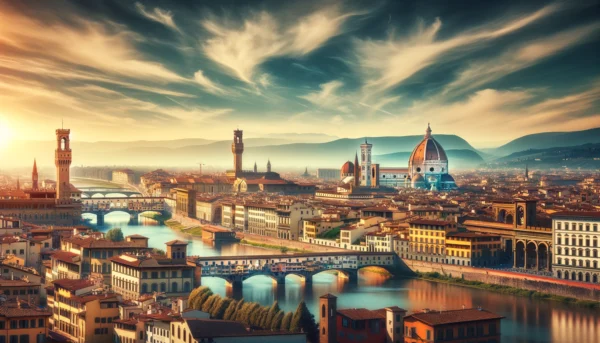
Practical Tips for Visiting Tuscany
Visiting Tuscany is a dream for many, and to make the most of your trip, here are some practical tips.
Best Time to Visit
Aim for spring (April to June) or early fall (September to October).
The weather is pleasant, and the tourist crowds are thinner.
Summer can be hot and crowded, while winter sees some attractions close or reduce hours.
Getting Around
Renting a car is often the best way to explore Tuscany, especially the rural areas and vineyards.
However, be prepared for narrow, winding roads.
Public transport is reliable for major cities, but less so for small towns and rural areas.
Accommodation
Consider staying in an agriturismo (a farm stay), which offers a rustic and authentic Tuscan experience.
In cities, boutique hotels or B&Bs are great for experiencing local hospitality.
Language
While English is widely spoken in tourist areas, learning some basic Italian phrases can enhance your experience and is appreciated by locals.
Local Cuisine
Embrace the local food culture.
Tuscan cuisine is known for its simplicity and quality ingredients.
Don’t miss trying local specialties like ribollita, pappa al pomodoro, and, of course, the famous bistecca alla fiorentina.
Wine Tastings and Tours
Book vineyard tours and wine tastings in advance, especially during peak seasons.
Many wineries offer a more intimate experience with a pre-booked appointment.
Cultural Etiquette
Tuscans are known for their relaxed lifestyle.
Embrace this slower pace and be respectful of local customs.
In dining, tipping is not mandatory but appreciated for good service.
Cash and Cards
While credit cards are widely accepted, it’s good to have cash for smaller shops and rural areas. ATMs are readily available.
Dress Appropriately
For visiting religious sites, ensure you dress modestly (covering shoulders and knees).
Comfortable walking shoes are a must, as you’ll likely do a lot of walking, often on cobblestones.
Day Trips and Tours
Consider taking guided day trips, especially if you’re short on time or want a deeper understanding of the history and culture.
Stay Connected
Get a local SIM card for easy access to maps, information, and communication.
Wi-Fi is widely available, but having mobile data is handy.
Pack for the Weather
Summers are hot, so lightweight, breathable clothing is ideal.
Spring and fall can be unpredictable, so layering is key. Winters are mild but can be wet.
Respect the Environment
Tuscany’s beauty is its unspoiled nature. Be mindful of your environmental impact.
Healthcare
Pharmacies are well-stocked, and medical care is good.
However, it’s advisable to have travel insurance just in case.
Enjoy and Relax
Finally, remember to slow down and savor every moment.
Tuscany is not just a destination; it’s an experience to be cherished.
With these tips in hand, you’re set to have a memorable and enjoyable Tuscan adventure. Buon viaggio!

Wine Purchasing and Investment: A Connoisseur’s Delight
For collectors, Tuscan wines are a treasure.
Investment-grade Wines like Sassicaia or Tignanello offer great potential.
These wines, especially older vintages, can appreciate in value.
Purchasing Tips: Look for reputable sellers, and consider storage conditions for maintaining wine quality.
The Best Vintages in Tuscany
Identifying the best vintages in Tuscany requires considering various factors such as weather conditions during the growing season, harvest quality, and how the wines have aged over time.
While vintage quality can vary between different wine regions in Tuscany and even among producers, some years have gained widespread acclaim for their exceptional quality.
Here’s a list of some of the most celebrated vintages from key Tuscan wine regions:
Chianti Classico
- 2015 & 2016: Both years are exceptional, with 2016 slightly edging out for its balance and structure.
- 2010: Known for excellent balance and aging potential.
- 2004 & 2006: Both were excellent years, producing structured and long-lasting wines.
Brunello di Montalcino
- 2015 & 2016: Outstanding vintages, with wines showing great complexity and aging potential.
- 2010 & 2012: Both vintages produced rich, well-structured Brunellos.
- 2006 & 2007: Excellent quality, with 2006 being particularly noted for its longevity.
Vino Nobile di Montepulciano
- 2016 & 2015: Exceptional years with wines of great finesse and aging potential.
- 2010: Noted for elegant, balanced wines.
- 2007: A very good vintage, producing accessible and aromatic wines.
Super Tuscans
- 2015 & 2016: Exceptional for Bolgheri and other regions producing Super Tuscans, known for their power and elegance.
- 2010: A great year, especially for wines that benefit from aging.
- 2004 & 2006: Both produced powerful and complex wines.
General Considerations
- Climate Variation: Keep in mind that Tuscany has a varied climate, so a vintage that is outstanding in one area might be merely good in another.
- Aging Potential: The best vintages often yield wines with excellent aging potential, developing more complexity and depth over time.
- Personal Preference: Your personal taste can also influence what you consider the ‘best’ vintage. Some might prefer the fruitier profile of younger vintages, while others might appreciate the complexity of older ones.
It’s important to note that even in less acclaimed vintages, top producers can still make outstanding wines.
The skill of the winemaker in managing the challenges of each growing season plays a crucial role in the quality of the wine produced.
As always, the best way to understand a vintage is to taste it!
Culinary Pairings and Recipes: A Gastronomic Journey
Finally, Tuscan wines shine brightest when paired with local cuisine.
Pairing Tips: Chianti is perfect with pasta and red sauces, while Brunello pairs well with game or steak.
For a culinary twist, try Recipes Using Tuscan Wines in sauces or stews, adding depth and flavor to traditional dishes.
Tuscany, with its rich culinary heritage, offers a plethora of dishes that perfectly complement its diverse range of wines.
Here are some quintessential Tuscan dishes and their ideal wine pairings.
Bistecca alla Fiorentina (Tuscan T-bone Steak)
This iconic grilled steak is best enjoyed with a full-bodied Tuscan red like Chianti Classico or Brunello di Montalcino.
The robust flavors of these wines match the richness of the meat.
Pappa al Pomodoro (Tomato and Bread Soup)
A rustic, hearty soup made with tomatoes, stale bread, garlic, and basil.
Pair it with a medium-bodied Chianti for a harmonious blend of acidity and fruitiness.
Ribollita (Tuscan Vegetable and Bread Soup)
This thick, comforting soup is made with bread, beans, and vegetables.
A Sangiovese-based red wine, such as a young Chianti, complements the earthy flavors of the soup.
Panzanella (Bread and Tomato Salad)
A refreshing summer salad, ideal with a crisp Tuscan white wine like Vernaccia di San Gimignano or a light red like Rosso di Montalcino.
Cacciucco (Tuscan Fish Stew)
A rich seafood stew from the coastal areas, bursting with flavors.
Pair it with a Tuscan Vermentino, which offers a crisp, mineral quality that enhances the seafood.
Pecorino Toscano (Tuscan Sheep Cheese)
This versatile cheese can range from soft and fresh to hard and aged.
Enjoy it with a variety of wines, from a fresh, zesty white like a young Vernaccia to a more robust red like Vino Nobile di Montepulciano.
Cantucci e Vin Santo (Almond Biscotti with Sweet Wine)
A classic Tuscan dessert, these almond biscuits are traditionally dipped in Vin Santo, a sweet dessert wine from Tuscany.
Wild Boar Ragù
Often served with pappardelle pasta, this rich and hearty sauce pairs wonderfully with a robust and earthy wine like Brunello di Montalcino or a complex Chianti Classico Riserva.
Each of these dishes reflects the rustic yet refined nature of Tuscan cuisine, characterized by simple ingredients of high quality.
When paired with the region’s wines, they create a symphony of flavors that beautifully showcases the harmony between Tuscan food and wine.
In conclusion, Tuscany’s wines and vineyards are a labyrinth of tastes, experiences, and knowledge.
Each visit, each bottle, each sip opens up new vistas of understanding and enjoyment.
From the casual wine enthusiast to the seasoned connoisseur, Tuscany has something to enchant everyone.
So, raise your glass to the timeless wines of Tuscany, where every drop tells a story of tradition, passion, and the art of winemaking. Salute!
FAQs:
Q1: What makes Tuscan wines unique?
A1: Tuscan wines are unique due to their specific terroir, which includes a favorable Mediterranean climate, diverse soil types, and traditional winemaking practices.
The predominant use of the Sangiovese grape in many iconic Tuscan wines, like Chianti and Brunello di Montalcino, contributes to their distinct character.
Q2: Can I visit vineyards in Tuscany?
A2: Absolutely! Many Tuscan vineyards offer tours and tastings.
Experiences range from casual tastings to in-depth tours of vineyards and cellars.
Some vineyards also offer luxurious accommodations.
Q3: What are Super Tuscans?
A3: Super Tuscans are a category of Tuscan wines that typically use non-traditional grape varieties for the region, like Merlot and Cabernet Sauvignon, either alone or blended with Sangiovese.
They often do not adhere to strict DOC/DOCG regulations, allowing winemakers more creativity.
Q4: When is the best time to visit Tuscan vineyards?
A4: The best time is during spring (April to June) or fall (September to October).
These periods offer pleasant weather and less crowded vineyards.
Harvest time in September can be particularly exciting to witness.
Q5: What types of food pair well with Tuscan wines?
A5: Tuscan reds like Chianti pair wonderfully with Italian cuisine, especially dishes with tomato-based sauces, grilled meats, and cheese.
Tuscan whites complement seafood, light pasta dishes, and appetizers.
Q6: Are Tuscan wines suitable for aging?
A6: Many Tuscan red wines, especially those from Brunello di Montalcino and high-quality Chianti, are well-suited for aging, developing more complex flavors over time.
However, there are also many approachable wines intended for immediate consumption.
Q7: What is Chianti, and how does it differ from Chianti Classico?
A7: Chianti is a red wine from Tuscany made primarily from Sangiovese grapes.
Chianti Classico refers to wines produced in the original, more strictly defined Classico area within the Chianti region.
Chianti Classico is often of higher quality and is required to have a higher percentage of Sangiovese.
Q8: Are there any notable white wines from Tuscany?
A8: Yes, while Tuscany is famed for its reds, it also produces notable whites like Vernaccia di San Gimignano and Vermentino, known for their crisp acidity and refreshing profiles.
Q9: What is Vin Santo?
A9: Vin Santo (‘holy wine’) is a traditional Tuscan dessert wine made from dried grapes, usually Trebbiano and Malvasia.
It has a rich, sweet character, perfect for pairing with desserts or as a standalone after-dinner drink.
Q10: How do I store Tuscan wines?
A10: Store wines in a cool, dark place at a consistent temperature, ideally between 12-18°C (55-65°F).
Bottles should be kept on their sides to keep the cork moist, especially important for wines meant for aging.

Elevate Your Wine Experience with Our Exclusive Aroma Kit
🍇 Discover the Subtle Notes of White Wine 🍷
Wine enthusiasts and aspiring sommeliers, your journey into the depths of wine aromas begins here! Our meticulously crafted 24 White Wine Aroma Taster Kit is more than just an accessory – it’s your gateway to mastering the art of wine tasting.
🌟 What’s Inside?
- 24 Expertly Selected White Wine Aromas: Uncover the hidden bouquets and subtle notes that define the world’s finest white wines.
- Elegant Tasting Glasses: Perfectly designed to deliver the true essence of each aroma.
- Comprehensive Guidebook: A treasure trove of knowledge, from aroma profiles to wine pairing tips.
🌿 Set Against the Idyllic Backdrop of Lush Vineyards, this kit is a testament to the rich history and diversity of white wines. Whether you’re hosting a wine tasting party or honing your sommelier skills, this kit is your companion in exploring the nuanced world of wine.
💡 Why Choose Our Aroma Kit?
- Enhance Your Tasting Skills: Train your palate to recognize and appreciate the complex flavors in each glass.
- Perfect for Wine Lovers and Experts: Whether you’re starting your wine journey or already a connoisseur, there’s always something new to discover.
- A Unique Gift Idea: Impress the wine aficionado in your life with a gift that’s both sophisticated and educational.
🎉 Embrace the Art of Wine Tasting: With our kit, every sip becomes a story, every aroma a memory. Join us in celebrating the exquisite world of white wines – your senses will thank you!
🔗 Explore the Aroma Kit on Amazon
🍾 Raise Your Glass to a New Level of Wine Appreciation! 🥂



